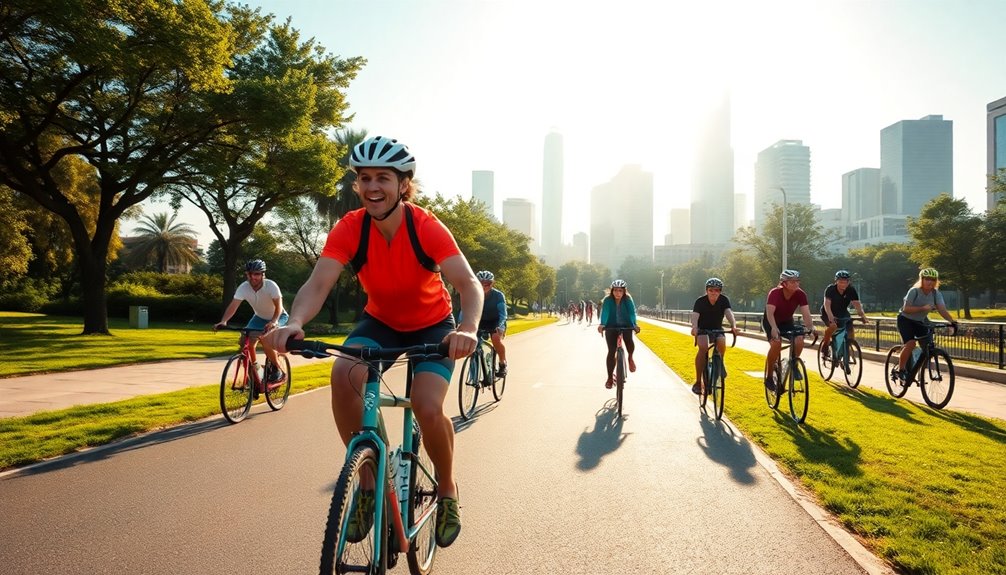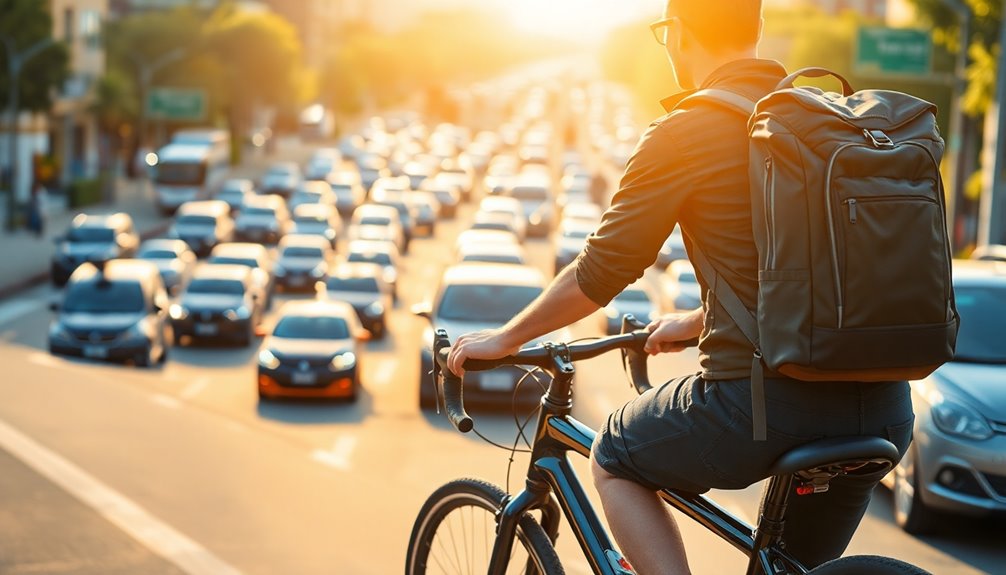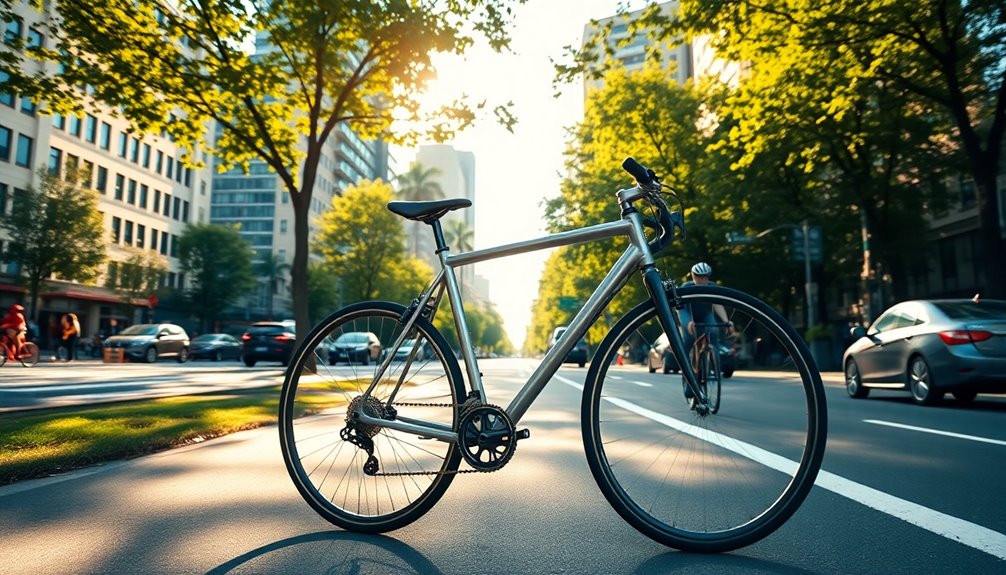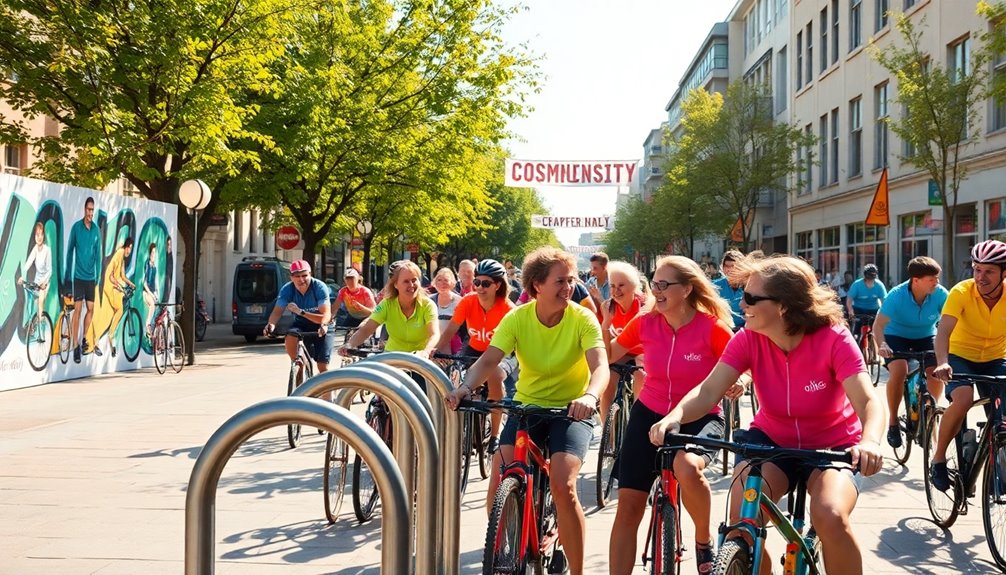Commuting by bike is a great way to boost your fitness on the go. It strengthens your leg muscles and enhances cardiovascular health while also improving mental well-being through endorphin release. This eco-friendly choice cuts CO2 emissions and saves you money by eliminating fuel and parking costs. Plus, it encourages a supportive cycling community. By embracing bike commuting, you'll not only transform your routine but also discover more benefits along the way.
Key Takeaways
- Commuting by bike strengthens leg muscles and improves overall physical fitness while enhancing cardiovascular health.
- Cycling aids in weight management by burning calories and boosting metabolism during daily commutes.
- Riding a bike releases endorphins, reducing stress and promoting a positive mood throughout the day.
- Biking decreases transportation costs, saving money on fuel, parking, and public transport fees.
- Regular cycling contributes to a cleaner environment by reducing CO2 emissions and improving air quality.
Physical Health Benefits of Cycling

When you choose to commute by bike, you're not just getting from point A to point B; you're also reaping significant physical health benefits.
Cycling strengthens your leg muscles, including your quadriceps, hamstrings, glutes, and calves. It boosts your cardiovascular health, improving heart function and lowering the risk of heart disease.
You'll enhance your flexibility by loosening muscles in your legs and hips. Plus, cycling aids in weight management by burning calories and improving metabolism, which helps prevent obesity.
Regular cycling builds your endurance and stamina, making daily activities feel easier. With its low-impact nature, cycling reduces stress on your joints, making it perfect for those with joint issues while improving your posture and balance. Additionally, engaging in regular physical activity, such as cycling, can help prevent financial considerations for elderly care, ensuring a healthier lifestyle for older adults.
Mental Health Advantages of Bike Commuting

While you pedal your way through the city, you're not just getting exercise; you're also nurturing your mental health.
Cycling releases endorphins, which help reduce stress and boost your happiness. You'll notice improved mental clarity and focus, making your workday feel more manageable.
Active commuting through cycling enhances your overall well-being, as studies show it correlates with lower risks of mental health issues. You're likely to feel better about yourself, as cycling often leads to better self-reported health.
Active commuting through cycling boosts your well-being and reduces mental health risks, leading to improved self-reported health.
Plus, longer commutes can further elevate your sense of well-being. By swapping your car for a bike, you not only enhance your mood but also decrease the chances of needing medication for mental health problems. Additionally, hydration support from regular exercise can further improve your mental state and overall health.
Environmental Impact of Cycling

Cycling not only benefits your health but also makes a significant positive impact on the environment.
When you choose to bike instead of drive, you help reduce CO2 emissions, saving over 16 million tons annually in the EU alone. Your biking also improves air quality, minimizing air pollutants and enhancing community health.
Plus, by cycling, you lower noise pollution, contributing to quieter neighborhoods, valued at 300 million euros each year.
With every bike ride, you're saving fuel—over 3 billion liters annually in the EU—while using fewer resources for production than cars.
Economic Savings From Commuting by Bike

Commuting by bike can lead to substantial economic savings for you. By eliminating fuel costs, parking fees, and public transport expenses, you can save over $2,500 annually in the U.S.
Bicycles require minimal maintenance compared to cars, reducing repair costs significantly. Plus, some employers offer tax breaks for biking to work, further lowering your expenses.
With these savings, you can increase your disposable income, allowing you to spend on other goods and services that boost your local economy.
In cities like New York, you could save $132 a month just by biking instead of using public transport. Over time, these savings can accumulate, making cycling a financially savvy choice. Additionally, the cost of living adjustments associated with biking can lead to further financial benefits as you avoid rising transportation costs.
Safety Considerations for Cyclists

When you choose to bike to work, safety should be a top priority. Urban areas pose higher risks, as 82% of bicyclist deaths occur here, often due to heavy traffic and complex road networks.
Always wear a helmet; 62.2% of those killed in crashes weren't wearing one. Helmets can significantly reduce fatal head injuries.
Always prioritize safety by wearing a helmet; they can greatly decrease the risk of fatal head injuries in crashes.
Avoid cycling under the influence, as over 20% of fatalities involve alcohol impairment. Plan your route carefully, opting for bike lanes or quieter roads, and steer clear of busy intersections.
Enhance your visibility with reflective gear and lights, especially at night. Regularly maintain your bike to prevent mechanical failures, ensuring a safer ride. Additionally, consider that inadequate maintenance of your bike can lead to decreased safety and performance, similar to how it affects heat pumps.
Getting Started With Bike Commuting

Starting your bike commuting journey can feel daunting, but with the right approach, it becomes manageable and enjoyable.
First, plan your route using cycling apps like Komoot or Google Maps to identify bike-friendly paths. Assess the distance to ensure it's manageable for you, and practice the route beforehand to become familiar with it. Allow extra time for unexpected delays, and keep an eye on the weather—prepare for rain or snow.
Remember to start slow; shorter distances are best at first. Familiarize yourself with local cycling laws, and learn basic maintenance skills for your bike.
Lastly, ensure your bike is comfortable and consider essential accessories like lights to enhance your safety.
Happy riding!
Choosing the Right Bike for Your Needs

After getting comfortable with bike commuting, the next step is selecting the right bike to suit your needs.
If you're navigating urban roads, consider a sturdy bike with thicker tires to handle rough surfaces. For mixed terrains, a hybrid or gravel bike offers versatility. If your commute is long, an e-bike can help you travel faster with less effort.
Think about your cargo needs; bikes with racks and fenders are great for carrying essentials. Also, assess your fitness level—if you're just starting out, an e-bike or one with easier gearing might be best.
Lastly, choose a frame material that balances weight and durability, like aluminum or steel, to ensure a comfortable ride. Additionally, investing in high-quality materials can enhance the longevity and safety of your bike, similar to how durable construction toys promote safety in play.
Planning Your Cycling Route Effectively

Planning your cycling route effectively can make all the difference in your commuting experience, whether you're looking for a scenic ride or a quick trip to work.
Start by using cycling route planner apps like Google Maps or Komoot, which let you customize routes based on your preferences, such as avoiding busy roads or choosing scenic paths. Planning on a desktop can be easier, thanks to larger screens.
Don't forget to check bike lanes and trails using map layers to enhance safety. You can also inspect unfamiliar roads with Street View before your ride.
Lastly, consider breaking longer trips into manageable segments and identify alternative routes for any challenging sections. This way, you'll enjoy a smoother, safer cycling experience.
Building a Supportive Cycling Community

Building a supportive cycling community is essential for encouraging more people to embrace biking as a viable mode of transportation. By organizing community events like bike rides and workshops, you engage new riders and foster support for cycling infrastructure.
Creating a supportive cycling community through events and workshops encourages more people to adopt biking as a transportation option.
Partnering with local organizations enhances your outreach, while ambassador programs help deepen connections. Make your initiatives inclusive by using diverse outreach methods and establishing feedback channels to tailor them to community needs.
Promoting dedicated bike lanes, integrated traffic systems, and bike parking facilities is crucial for safety and convenience. Offering learn-to-ride classes and community rides empowers new cyclists.
Regularly hosting themed rides and using social media can further engage the community, helping to create a vibrant culture around cycling.
Frequently Asked Questions
What Types of Bikes Are Best for Different Commuting Environments?
When choosing a bike for different commuting environments, consider your needs.
For smooth roads, road bikes excel in speed, while hybrid bikes offer comfort for mixed surfaces.
If you tackle hilly terrain, mountain bikes or e-mountain bikes provide the necessary durability.
For long distances, endurance road bikes and touring bikes are ideal.
In mixed environments, gravel bikes and commuter bikes with wide tires ensure stability and versatility.
Choose what fits your journey best!
How Can I Maintain My Bike for Optimal Performance?
Imagine your bike as a trusty steed; if you neglect its care, it won't carry you far.
To maintain optimal performance, regularly lubricate your chain, check tire pressure before every ride, and inspect brakes frequently.
Think of it like tuning an instrument; each adjustment ensures a smooth ride.
Stay proactive with pre-ride checks and clean your drivetrain often, and you'll enjoy a reliable companion on all your journeys.
What Should I Wear While Biking to Work?
When biking to work, you should wear comfortable, breathable clothing that wicks moisture away.
Start with a good base layer and padded shorts for comfort. A cycling jacket can protect you from wind or light rain, while reflective gear ensures you're visible.
Depending on the season, layer appropriately—think winter tights or summer shorts.
Don't forget a helmet for safety, and pack spare clothes if you need to change at work.
How Can I Ensure My Bike Is Secure When Parked?
Did you know that over 1.5 million bikes are stolen each year in the U.S.?
To ensure your bike's security when parked, lock your frame and both wheels to a sturdy, immovable object using a high-quality U-lock.
Choose well-lit, visible areas with pedestrian traffic, avoiding isolated spots.
Consider using designated bike racks and always secure your bike, especially overnight, to minimize the risk of theft.
Your vigilance makes all the difference!
Are There Any Apps to Help Track My Cycling Routes?
Yes, there are several great apps to help you track your cycling routes.
Strava offers GPS tracking and social features to connect with other cyclists, while MapMyRide provides route mapping and nutrition tracking.
If you're looking for user-generated routes, try Bikemap. For route planning, Komoot is excellent, and Cyclemeter turns your smartphone into a customizable cycling computer.
Each app can enhance your riding experience and help you stay motivated on your journeys.
Conclusion
Incorporating bike commuting into your routine is like planting a seed for a healthier, happier life. Not only do you boost your physical and mental well-being, but you also contribute to a cleaner environment and save money. By embracing this lifestyle, you're not just cycling to work; you're pedaling toward a brighter future. So grab your helmet, hit the road, and watch the benefits bloom as you join a vibrant community of fellow cyclists.









